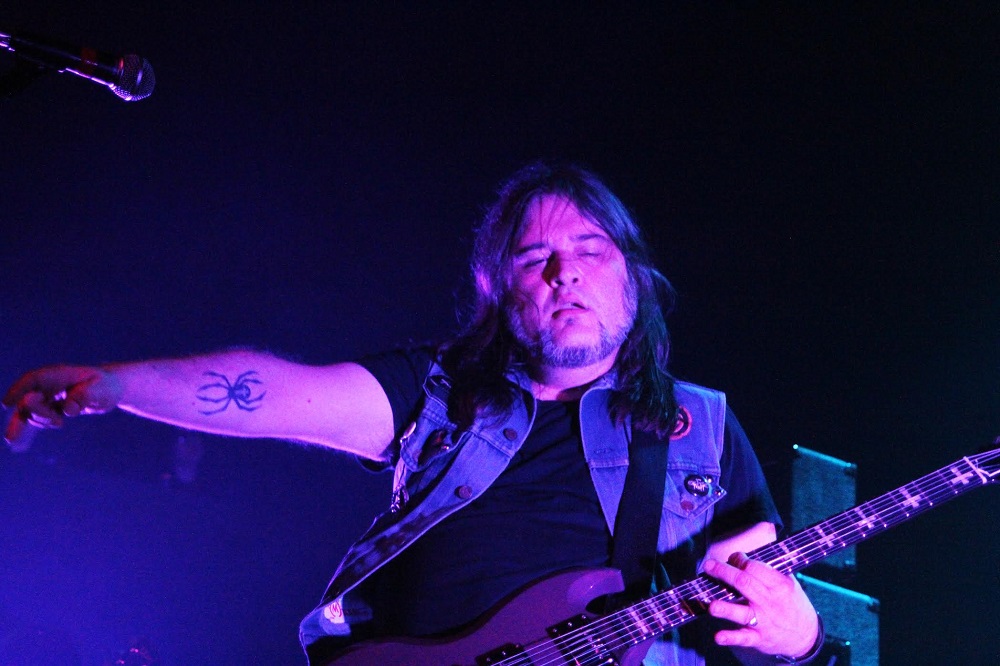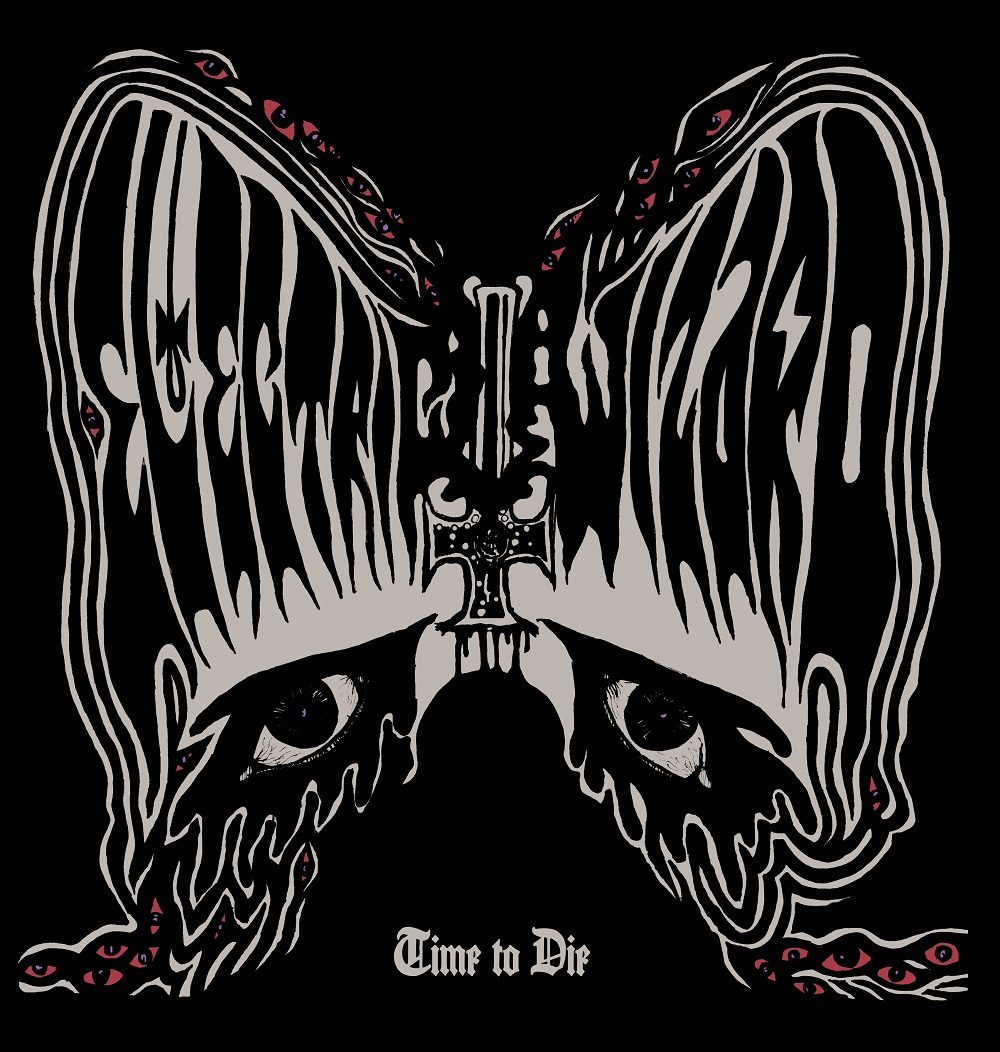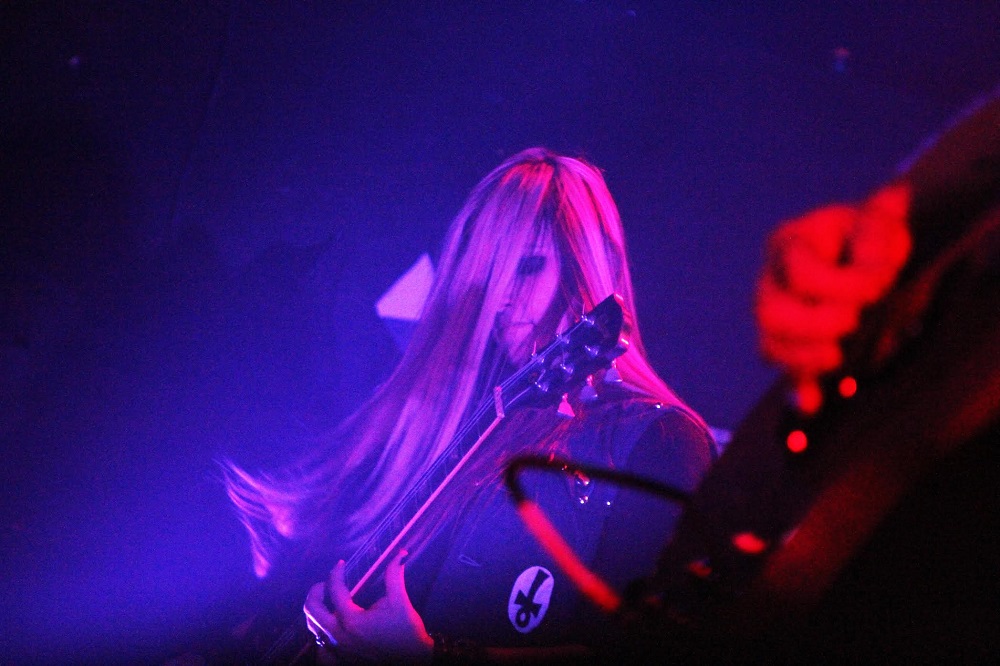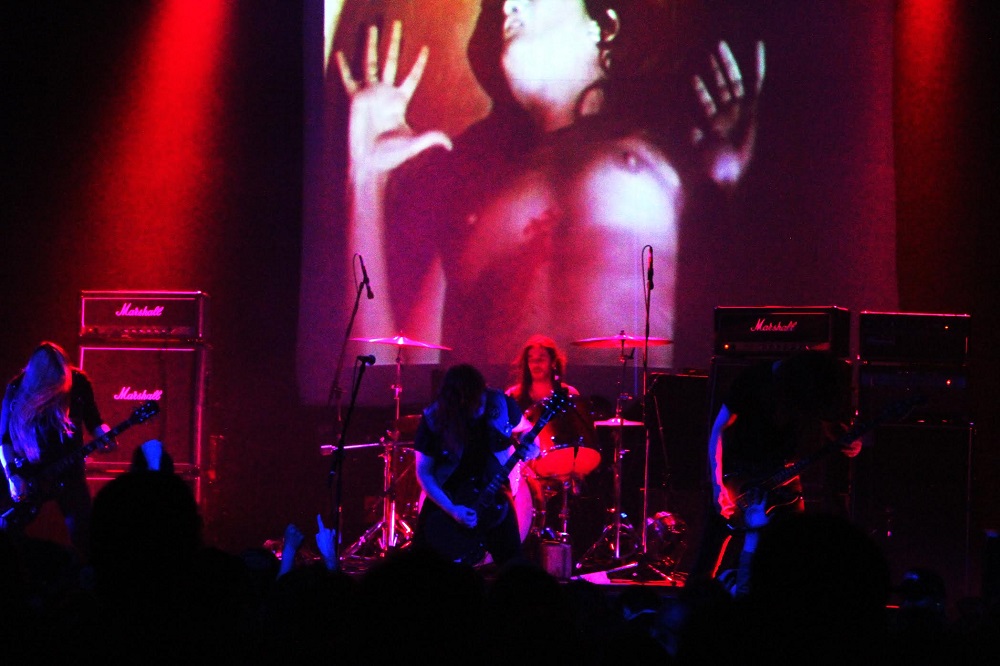
(All photos of Electric Wizard by bev davies, taken at the Rickshaw Theatre, April 14, 2015)
The thing that fascinates me about Electric Wizard is, I can’t actually tell where sincerity stops and irony takes over. Leader/ guitarist Jus Oborn seems to be a pretty smart guy, and some of his influences are obvious – HP Lovecraft, Jess Franco, 60’s and 70’s occult horror films, vintage gear, and old-school Black Sabbath -style stoner metal – but – besides wanting to make heavy as fuck, unashamedly retro music with an evil aura to celebrate said influences – what is he serious about? What does he really believe? When he sings about raising “the flag of hate against the human race,” says in his lyrics he would treat the world like Caligula if he could… is he serious? Is he speaking for himself, or entering a character for the sake of a song, or…?
No doubt the EP title Legalize Drugs and Murder is a joke, and that the black light posters for sale at the Rickshaw during their recent Vancouver show – picturing a devil and two staring, disembodied eyes – are an ironic gesture (though I’m not sure the people buying them were responding to them as such. Do people really have black lights again? Can you even get them?). The current tour t-shirt has a dominatrix on the back and the words “world domination tour,” which also seems pretty tongue-in-cheek and witty. These things suggest the band doesn’t take itself entirely seriously, have at least a sense of humour about what they’re doing. That’s all quite welcome, in fact. I’ve never really understood when people complain that figures in metal – Glen Benton of Deicide or whomever – aren’t really sincere Satanists. I’ve never really thought being a sincere Satanist a virtue, at least not when it comes to making music.
But why theme an album around Ricky Kasso? It’s a fascinating, compelling move – and Time to Die, the new Electric Wizard album, is right up there, in my books, with their acknowledged classics like Dopethrone, Witchcult Today, and Come My Fanatics. But devoting a whole album around the real life, crimes, and death of a 17 year old self-described Satanist, known as “the Acid King” for his prolific drug consumption, who stabbed another teenager to death, demanding that he say he loved Satan, while both of them were high on psychedelics, is a pretty terrifying thing to do. Or pick your own adjective – misanthropic? Irresponsible? Troubling? Questionable? Tasteless?

I mean, I once killed a cranefly while I was on acid, but I had good reason: the little beast had uninvitedly violated my holy of holies while I was naked on the floor, ass in the air, drawing pictures with pencil crayons on the floor of my bedroom in my parents’ apartment. I swatted at the bug, and it got angry at me, flew aggressively towards me. I had previously seen it in the apartment sucking up the spilled juice of a tomato I’d made a sandwich with, and tried to bond with it – it’s hungry, I’m hungry, we’re both alive, aww – so when it happened, I took its flying into my asshole as a personal violation. I decided to destroy the thing, to briefly manifest the murderous energies of the universe, incorporate them into the trip: a death trip, if you will. It felt powerful, I must admit, killing that cranefly. Nevermind all the peace-and-love stuff, just ask Charles Manson: acid does have a dark side.
But Ricky Kasso?
I’ve been unable to track down the true crime paperback, Say You Love Satan, that tells Kasso’s story, so I’m left with Wikipedia, if I want to flesh out the bits of spoken narration that recount the murder, in between songs on the Time to Die.
We learn that after a feud involving stolen drugs, Kasso led a former friend, Gary Lauwers, with two other youths, into the woods in Long Island, on June 16, 1984. Kasso allegedly wanted to make peace with Lauwers – or else was just using that as a pretext, because things finally turned ugly.
Quoting: “Kasso continued his assault on [victim Gary ] Lauwers for an extended period of time, which was reported to have lasted three to four hours… Lauwers was stabbed somewhere between 17 and 36 times, incurred burns, and his eyeballs had been gouged out. It was also reported that stones had been shoved down his throat. During the attack, Kasso allegedly commanded Lauwers to ‘Say you love Satan,’ but Lauwers is said to have instead replied “I love my mother”. After the attack, Kasso and [a witness/ participant] covered Lauwers’ body with leaves and small branches. As the group was departing Aztakea, Lauwers was reported to have sat up and repeated ‘I love my mother,’ causing Kasso to resume the attack until he was certain that Lauwers had died.”
Kasso then “bragged about the murder to local teens, claiming the murder was a ‘human sacrifice.’ Kasso told some that he had murdered Lauwers because Satan had commanded him to. Kasso claimed Satan manifested in the form of a black crow, and that the crow had cawed, something he interpreted as Satan’s command to murder Lauwers.” Electric Wizard makes a point of including a few crow caws in the background of the songs most directly relating to Kasso, along with other nature sounds, befitting the forested environment where the crime took place.
Kasso was eventually arrested, two days after which he hanged himself in his prison cell, dedicating that gesture, as well, to Satan (though that part gets omitted from Wikipedia).

For me, Kasso’s is a sad story, about someone deeply lost, alienated, confused – even if he didn’t experience his life that way. It’s a story about someone for whom the social mechanisms that are supposed to catch kids, to keep them from plummeting into the abyss not only failed, but moved out of the way, maybe even gave him a push; it’s a story about total fucking waste and failure and violent, ugly folly, with nothing to celebrate therein. (I have my own experiences of waste, failure, and folly from my druggie suburban youth, so I might be a little sensitive here). Hearing that Kasso’s victim kept insisting, while being stabbed to death, that he loved his mother, is heartbreaking, and no less so because I can imagine myself as a young man somewhere in this story, myself. If I had kids, and they were listening to this music, I would want to have a talk with them, would want to do a reality-check. To end “Incense for the Damned,” the first song on the album, with a chant of “we want to get high before we die” – to try to turn one teenager uselessly murdering another because of some misguided bullshit in his head about Satan into something approaching an anthem – is kind of shocking, at the very least. What’s even more shocking is that I don’t see anyone reacting to this; there are whole interviews with Oborn, dealing with precisely this album, where no one even bothers to ask him about Kasso.
This is very strange to me. Maybe it’s just the nature of metal these days. Maybe bands like Cannibal Corpse have put so much carnage into their lyrics that pretty much everything is permitted, nothing taken seriously – there’s no level of gore, violence, or misanthropy that can cause metalheads to blink and do a double-take anymore. Oborn himself seems a bit distressed by this sad state, talks elsewhere about the band’s “nihilistic and negative obsession with death, suicide, and self-annihilation,” and complains that people are “hard to shock” nowadays, in another interview that makes no mention of Ricky Kasso at all…

Electric Wizard at the Rickshaw, by bev davies
So just for the record, Jus? I’m shocked. Love it though I do, I find Time to Die an unsettling, creepy, and deeply disturbing journey, and worry that it might just be a kind of immoral gesture, depending on how you mean it. (Not saying that’s necessarily a bad thing, tho’). I would like to be able to read it as a meta-level commentary on heavy metal nihilism… but maybe that would presume an ironic distance that I’m not seeing much sign of (tho’ the black light posters gave me a bit of hope). Part of me went to see Electric Wizard in Vancouver because I wanted to put my worries to rest, hoped for enlightenment about what the band is about. I hoped to be set at ease, maybe by seeing that they don’t really “mean it, maaan.” I wanted them to make it safe for me to love them as much as I’d like to.
No enlightenment or reassurance was forthcoming. The night went down like this:1. When I got in, half an hour before the show began, there was already a ridiculously long line at a merch table. I’m used to a crowd of people three deep, but this was a frigging queue, with about fifty people in it, extending from the back corner of the venue, across the floor, and back up the stairs. I got in line because a sign I spied on the table said there was vinyl, but after half an hour, discovered, when I finally arrived at the merch, that only opening act Satan’s Satyrs had LPs. I bought a $25 t-shirt because otherwise the time spent in line would have been wasted. When I got back to my seat, the line was twice as long, and the opening act was on. Metalheads sure do like their merch; at least the prices were reasonable.

(bad photo of Satan’s Satyrs by Allan MacInnis)
2. Opening band Satan’s Satyrs, who share a member with Electric Wizard, bassist Clayton Burgess, have a logo that evokes biker culture, with a Nazi-style “SS” for the initial letters of their name and both an upright and inverted cross present in the T’s. They seem totally sincere about what they’re doing, but their songs lack the complexity or mood of Electric Wizard, or the measured anthemic hookiness. They seem less like songs than pretexts for Jarrett Nettnin’s extended guitar solos (which admittedly are pretty great, in a heavy psychedelic blues vein; it’s unsurprising to read the band have done sets dedicated to the music of Blue Cheer). Satan’s Satyrs kept reminding me of Japanese genre worshippers like High Rise, Mainliner, or the hardest-rockin’ incarnations of the Acid Mothers Temple – bands for whom arriving at and replicating 60’s and 70’s American rock culture is an end in itself, where nothing else needs be said or accomplished if you just rock out like a motherfucker and look cool while doing it. Which is fine – they did both – but their music didn’t exactly take your mind off the fact that you were waiting for the main act to take the stage.
3. Electric Wizard, or at least some key members thereof, clearly are movie geeks, and from the outset had a ceaseless stream of images on three screens beside them, most of which involved boobs. Boobs of psychedelic go go dancers; boobs of vampire lesbians; boobs of women in kinky S&M transactions or about to be offered as ritual sacrifices. Many seemed to be clips from movies, but none that I recognized. Occasionally there was a bit of variety, as when images of fire and lava served as a background for “Incense for the Damned,” or when a mini-narrative in the background of “Time to Die” told the story of a girl who dropped a tab of acid from the mouth of a skull, then appeared to have a bad trip, where the skull – a strangely pinched-in, malformed one – kept reasserting itself, hovering and flashing onscreen as she curled into a foetal ball and psychedelic patterns swirled assaultively around her. Everything was deeply retro – even the way the tits hung seemed somehow to evoke 1960’s and 70’s softcore – but it got to be a little lazy-seeming, maybe even demeaning to the audience. Sure, boobs are fun to look at, but maybe we could trade it up a little, folks? True that most of the audience is male, and yes, we do like boobs, but it’s not the ONLY thing we like to look at in a night. One wonders what Liz Buckingham, Oborn’s wife and second guitarist, makes of all the tit action…?

(photo by bev davies)
4. Whatever you make of their lyrics, Electric Wizard appears to have no bullshit to them at all; they obviously take their music pretty seriously, because all other considerations – like atmospheric lighting, theatricality, dynamic performances, a “stage show” or stage patter – were secondary, even negligible. Compared to a band like Mayhem, who used fog, lights, strobes, props, and costumes to powerful and entertaining affect when I saw them in the same venue a few years previous, Electric Wizard were (sorry) pretty boring to watch, in fact. Jus Oborn is a fucking amazing guitarist, and not lacking in charisma when playing, but I’m pretty that it was him who popped up onstage during soundcheck, lingering to make sure everything was to his satisfaction, without anyone whooping or cheering or reacting at all, because he’s ultimately a pretty ordinary looking guy, doesn’t wear his rockstardom like a halo or a badge or costume. He could have been another roadie. (If the guy I’m thinking of was actually, in fact, just another roadie, he had every bit of the presence of Oborn). He also didn’t have much to say between songs. “Are you the chosen ones?” is as cool a line to invite cheers with as any, I suppose, but it was also one of the only times I heard him actually address the audience, besides announcing a song title here and there. What makes Oborn remarkable to watch is how deeply he seems to enter his solos, often playing with his eyes closed, completely transported by them. Those who like a little black metal theatricality with their shows, though – well, here’s hoping they enjoyed the boobs, because that’s about the only bullshit the band had truck with…
5. But of course the lack of bullshit, from another perspective, was in itself kind of inspiring. There were no bad reasons to be in the audience that night – no need for eviler-than-thou one upmanship, no need for posing, no basking in star power auras, hoping some celebrity or charisma might rub off on you, make you suddenly important, in the vein of some fascist power trip, worshipping the charismatic leader or so forth. There’s plenty of bullshit of those varieties at any rock show, really, but the audience for Electric Wizard seemed – with perhaps the exception of me, the squinty, cerebral semi-outsider – to be totally, sincerely, non-ironically engaged with the MUSIC that was being made. They had to have been, because there was nothing else to draw them or keep them, and by damn there were a lot of them out; the place was packed, had sold out months in advance (Mayhem, by contrast, still had plenty of tickets available the night of their first Vancouver show, the Rickshaw only filling up as the band finally came onstage).
6. And as for the music… I’ve got nothing useful to say about it, sorry to report. I was too busy thinking, or scribbling notes, or being elbowed in the stomach or stepped on or bounced into, to really lose myself in the music the way I can with headphones on or in my comfy chair in front of the turntable. Those are still my favourite ways to listen to Electric Wizard. I would suggest you just go buy an Electric Wizard album (Time to Die is a fine place to start) or see them live if you can, rather than askin’ me to describe what they do. If you like it heavy, dark, and guitar-centric, for my money, the band in their present incarnation is out-Sabbathing Sabbath, are one of the best things out there, even if I find them a little, uh, scary.
My notes from the night don’t offer much else. The set began with “WItchcult Today,” followed with “Black Mass,” “Satanic Rites of Drugula,” the title track off “Dopethrone,” “Return Trip,” and the first (best) side of Time to Die, all expanded and intensified live, each of the night’s nine songs easily clocking in at the eight-to-ten minute mark. I ducked out during “…A Chosen Few,” before things came to a full close with “Funeralopolis.” My only other observation of note was that the venue smelled strongly of incense at the start of the night. It smelled like a very different kind of incense by the end.
As for the romance of drugs… on the way to the show, located at the Rickshaw theatre – a fantastic venue based on a refurbished Shaw Brothers theatre, but located in the skuzziest part of East Vancouver, near Main and East Hastings, with rats in the alleyways and people shooting up openly on the street – I overheard on the bus a murder-and-drugs themed conversation that was apparently part of a drug deal taking place. A few days prior to the show, someone had gone on a rampage with a knife a few blocks from the theatre, until being shot dead by cops, and a drunken dealer of some sort was trying to use the story of said rampage to convince a prospective customer to trust him to have inside knowledge of where to buy dope. The would-be dealer kept insisting, “seven stabbed, four dead, I was there,” or saying things like “Seven fucking knifed! I know the hood,” returning to his pet theme the way drunks will, then alternating it with promises to his compatriot that “you’ll try a tester, we’ll hook you up.” The two of them lurched off the bus at the same stop as me, staggering down the street on emaciated, junky legs, working their way towards their high, while I made my way to the concert.
Legalize drugs and murder indeed!